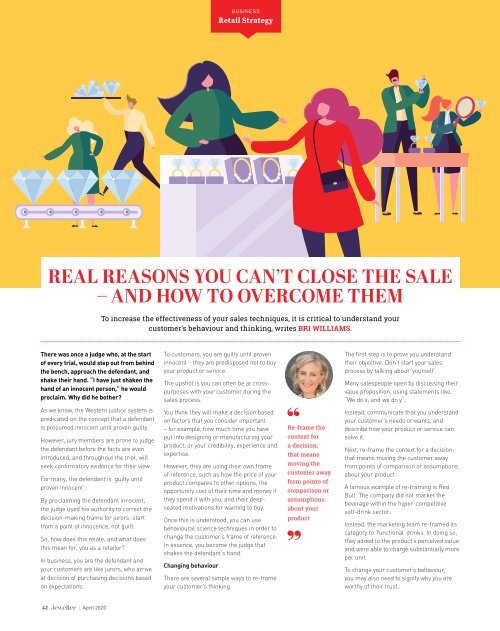Jeweller - April 2020
• Conquering Coronavirus: protect and prepare your business during the pandemic • Time frame: exploring five years of change in the watch category • Watch this space: a showcase of best-selling and new release watches
• Conquering Coronavirus: protect and prepare your business during the pandemic
• Time frame: exploring five years of change in the watch category
• Watch this space: a showcase of best-selling and new release watches
You also want an ePaper? Increase the reach of your titles
YUMPU automatically turns print PDFs into web optimized ePapers that Google loves.
BUSINESS<br />
Retail Strategy<br />
REAL REASONS YOU CAN’T CLOSE THE SALE<br />
– AND HOW TO OVERCOME THEM<br />
To increase the effectiveness of your sales techniques, it is critical to understand your<br />
customer’s behaviour and thinking, writes BRI WILLIAMS.<br />
There was once a judge who, at the start<br />
of every trial, would step out from behind<br />
the bench, approach the defendant, and<br />
shake their hand. “I have just shaken the<br />
hand of an innocent person,” he would<br />
proclaim. Why did he bother?<br />
To customers, you are guilty until proven<br />
innocent – they are predisposed not to buy<br />
your product or service.<br />
The upshot is you can often be at crosspurposes<br />
with your customer during the<br />
sales process.<br />
The first step is to prove you understand<br />
their objective. Don’t start your sales<br />
process by talking about ‘yourself’.<br />
Many salespeople open by discussing their<br />
value proposition, using statements like,<br />
“We do x, and we do y”.<br />
As we know, the Western justice system is<br />
predicated on the concept that a defendant<br />
is presumed innocent until proven guilty.<br />
However, jury members are prone to judge<br />
the defendant before the facts are even<br />
introduced, and throughout the trial, will<br />
seek confirmatory evidence for their view.<br />
For many, the defendant is ‘guilty until<br />
proven innocent’.<br />
By proclaiming the defendant innocent,<br />
the judge used his authority to correct the<br />
decision-making frame for jurors: start<br />
from a point of innocence, not guilt.<br />
So, how does this relate, and what does<br />
this mean for, you as a retailer?<br />
In business, you are the defendant and<br />
your customers are like jurors, who arrive<br />
at decision of purchasing decisions based<br />
on expectations.<br />
You think they will make a decision based<br />
on factors that you consider important<br />
– for example, how much time you have<br />
put into designing or manufacturing your<br />
product, or your credibility, experience and<br />
expertise.<br />
However, they are using their own frame<br />
of reference, such as how the price of your<br />
product compares to other options, the<br />
opportunity cost of their time and money if<br />
they spend it with you, and their deepseated<br />
motivations for wanting to buy.<br />
Once this is understood, you can use<br />
behavioural science techniques in order to<br />
change the customer’s frame of reference.<br />
In essence, you become the judge that<br />
shakes the defendant’s hand.<br />
Changing behaviour<br />
There are several simple ways to re-frame<br />
your customer’s thinking.<br />
Re-frame the<br />
context for<br />
a decision;<br />
that means<br />
moving the<br />
customer away<br />
from points of<br />
comparison or<br />
assumptions<br />
about your<br />
product<br />
Instead, communicate that you understand<br />
your customer’s needs or wants, and<br />
describe how your product or service can<br />
solve it.<br />
Next, re-frame the context for a decision;<br />
that means moving the customer away<br />
from points of comparison or assumptions<br />
about your product.<br />
A famous example of re-framing is Red<br />
Bull. The company did not market the<br />
beverage within the hyper-competitive<br />
soft-drink sector.<br />
Instead, the marketing team re-framed its<br />
category to ‘functional’ drinks. In doing so,<br />
they added to the product’s perceived value<br />
and were able to charge substantially more<br />
per unit.<br />
To change your customer’s behaviour,<br />
you may also need to signify why you are<br />
worthy of their trust.<br />
42 | <strong>April</strong> <strong>2020</strong>


















